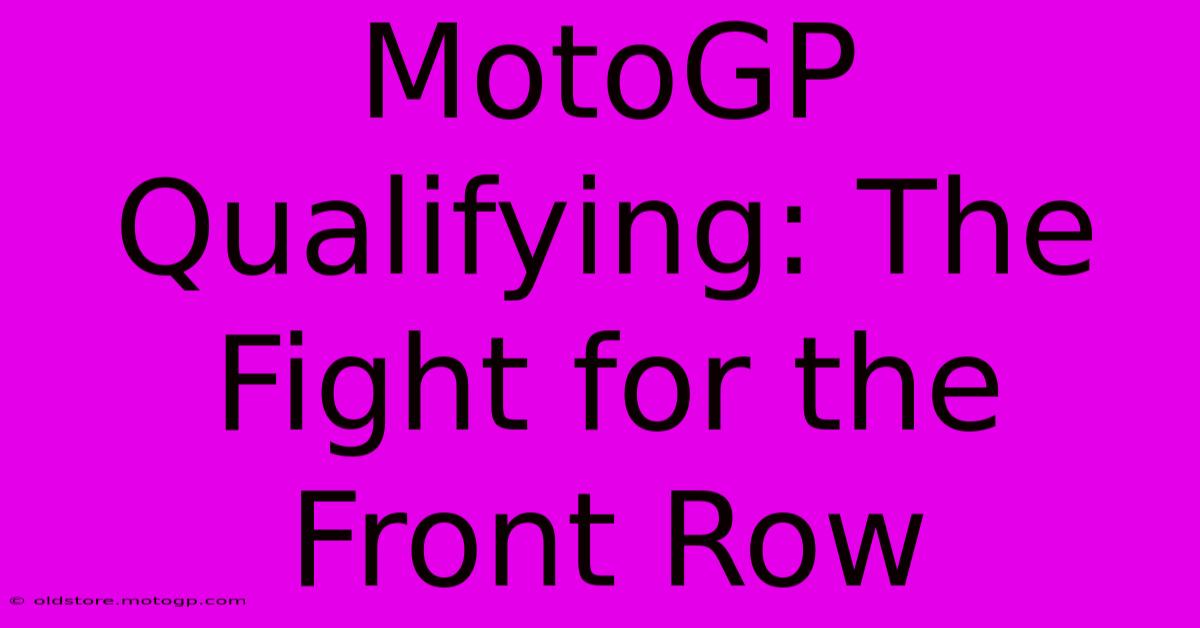MotoGP Qualifying: The Fight For The Front Row

Table of Contents
MotoGP Qualifying: The Fight for the Front Row
MotoGP qualifying is more than just a session to determine grid positions; it's a high-stakes, nail-biting spectacle that often dictates the race outcome. The fight for the front row, that coveted space on the grid, is a ferocious battle of skill, strategy, and nerves. This article delves into the intricacies of MotoGP qualifying, exploring the factors that contribute to success and the drama that unfolds each weekend.
Understanding the Qualifying Format
The current MotoGP qualifying format is designed to maximize excitement and create a clear pecking order. It's a multi-stage process, building tension with each passing lap:
Q1 (Qualifying 1):
- This session involves the slowest ten riders from the combined free practice times (FP1, FP2, and FP3).
- They have a limited time (15 minutes) to fight for the remaining four spots in Q2.
- Only the top two riders from Q1 progress to the next round. The pressure is immense. A single mistake can mean starting further down the grid.
Q2 (Qualifying 2):
- The top ten riders from the combined free practice sessions automatically qualify for Q2.
- This 15-minute session is where the true battle for pole position takes place. The intensity is palpable as riders push their machines and themselves to the absolute limit.
- The top rider at the end of Q2 secures pole position, followed by the rest of the top twelve forming the first four rows on the starting grid.
The Keys to Qualifying Success
Securing a place on the front row isn't a matter of luck; it requires a blend of several crucial elements:
1. Exceptional Riding Skill:
- Precision and Control: MotoGP qualifying demands pinpoint accuracy. Riders must navigate the track with flawless precision, maximizing every inch of tarmac. A slight error can cost valuable tenths of a second.
- Racecraft and Overtaking Ability: While qualifying focuses on individual lap times, understanding racecraft is important for positioning and anticipating traffic.
- Tire Management: Choosing the right tires and managing their wear throughout the qualifying session is crucial. Overheating or excessive wear can lead to costly mistakes.
2. Optimal Bike Setup:
- Engine Performance and Tuning: Every horsepower counts in qualifying. Teams meticulously fine-tune their bikes' engines to extract maximum performance from the track's unique characteristics.
- Aerodynamics and Chassis Balance: Aerodynamic efficiency is paramount, reducing drag and enhancing speed through corners.
- Electronics and Traction Control: Sophisticated electronics help riders maintain control and maximize traction, especially under heavy acceleration and braking.
3. Teamwork and Strategy:
- Data Analysis: Teams use extensive data analysis to optimize bike setup and racing lines. This involves scrutinizing lap times, telemetry data, and rider feedback.
- Track Conditions: Understanding and adapting to track conditions, including temperature, grip, and wind, is vital for achieving optimal performance.
- Pit Crew Efficiency: A well-coordinated pit crew ensures that tire changes and bike adjustments are executed swiftly and efficiently, maximizing track time.
The Drama of Qualifying: More Than Just Lap Times
MotoGP qualifying is far more dramatic than just a list of lap times. It's a captivating display of human skill and technological marvel. The tension is palpable as riders push themselves to the edge, the roar of the engines echoing the intensity of the competition. Overtakes, near misses, and unexpected crashes all add to the spectacle, keeping fans on the edge of their seats. The fight for that front-row spot is a microcosm of the entire race, a thrilling preview of the battles to come.
The Impact of Starting Position
A strong qualifying performance significantly influences the race outcome. Starting from the front row offers considerable advantages:
- Clean Run: Riders avoid the chaos of the first few corners, crucial for maintaining momentum and avoiding collisions.
- Early Control: Leading from the start allows riders to dictate the pace, potentially breaking away from the pack.
- Psychological Advantage: Securing pole position offers a major psychological boost, enhancing confidence and potentially intimidating rivals.
In conclusion, MotoGP qualifying is a crucial element of the Grand Prix weekend. It's a high-octane spectacle that showcases the skill, strategy, and teamwork needed to succeed at the pinnacle of motorcycle racing. The fight for the front row is a microcosm of the larger battle for championship glory, a testament to the dedication and precision of riders and their teams.

Thank you for visiting our website wich cover about MotoGP Qualifying: The Fight For The Front Row. We hope the information provided has been useful to you. Feel free to contact us if you have any questions or need further assistance. See you next time and dont miss to bookmark.
Featured Posts
-
Mastering The Machine Understanding Moto Gp Engine Dynamics
Feb 22, 2025
-
Moto Gp Bike For Sale The Ultimate Upgrade
Feb 22, 2025
-
Become A Moto Gp Champion Play The Arcade Game
Feb 22, 2025
-
Cota Austin Experience The Thrill Of Racing With Our Schedule
Feb 22, 2025
-
The Ultimate F1 Fan Experience Awaits At Club Si Austin F1
Feb 22, 2025
